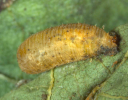 |
Scientific nameParagus serratus (Fabricius)
Taxonomic positionDiptera: Brachycera: Cyclorrhapha: Syrphidae: Syrphinae: Paragini
DiagnosisEyes hairy, hairs arranged in three longitudinal stripes, forming a pattern of light and dark areas; contiguous in male, more widely separated in female. Antennae dark brown to black, arista bare. Mesonotum shiny, blue-black, with a pair of greyish longitudinal median stripes, anteriorly confluent, posteriorly divergent, more or less inverted V-shaped; a pair of very short, narrow, transverse grey stripes present lateral to these stripes a little before middle. Scutellum anteriorly black, posteriorly yellowish, posterior margin with a series of serrations / teeth-like projections. Abdomen with variable coloration, in general 1st tergite black, sometimes partly or wholly reddish brown; tergite 2 reddish to orange-brown, anterior margin and / or sides blackish; tergites 3-5 completely brown /
yellowish / black or with median and lateral portions black; tergites 3 and 4 with a pair of white bands on either side of anterior margin; tergite 5 with a similar, but medially confluent and often broader white band; tergite 6 orange-brown to black, with whitish apical pubescence. Legs with coxae, anterior portion of fore femora, posterior half of middle femora, and most of hind femora, blackish; hind tibiae and hind tarsi dark brown to black, rest of legs orange or bright yellowish. In ventral view, apical abdominal sternites orange-brown to greyish and asymmetrical in male, black and symmetrical in female.
ImagesDistributionWidely distributed in India.
Prey / BiologyFeeds on a variety of aphids (Hemiptera: Aphididae) such as Acyrthosiphon pisum, A. spiraecola, A. craccivora, A. fabae, A. gossypii, Lipaphis erysimi, Melanaphis sacchari, Tetraneura nigriabdominalis, Therioaphis trifolii, Toxoptera aurantii, and T. citricida (Ghorpade, 1981). Associated with cotton, dolichos, ragi, mustard, gooseberry, redgram, sorghum, sugarcane, sweet potato and water melon (Ghorpade, 1981). Joshi et al. (1999; 2000) studied its predatory potential and worked out the age-specific life table on various aphids.
References
|









